
A Cave of Candles / by Dorothy V. Corson

Chapter 26
A Fire Sparks Renewed Interest in the Grotto
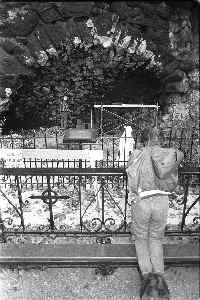
This story would not be complete without a description of the almost disastrous fire at the Grotto in the predawn hours of September 24, 1985, when the Grotto was loaded with lighted candles, said to be some 1500, during a Michigan State game, which Notre Dame won 27-10. Though a sad occasion, the focus of attention drawn to the Grotto served to bring out in words many heartfelt feelings about it.
I owe a firsthand account of that fire to Brother Borromeo Malley, who was fire chief at the time. He has been associated with the Notre Dame campus for 60 years and is now retired and living at Holy Cross House on campus. We met by chance while I was documenting this story.
Ours was another of those chance encounters that have happened so fortuitously during the time I have been gathering information about the Grotto. I was about to leave Holy Cross House after a my usual Friday visit and seeing Brother Borromeo waiting there I asked him if he needed a lift. He explained that he had a car and was about to leave himself when he noticed the road was congested with cars from an accident in front of Moreau Seminary. He had decided to wait until it cleared. Then he grinned, mischievously, and said, "The only thing I have to do in this life is die, and I can do it just as well here as out there." We both sat down to wait and our conversation about the Grotto flowed from that happenstance meeting.
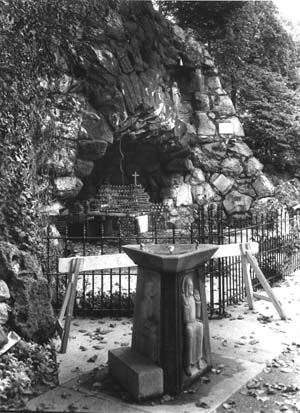
Brother Borromeo, straightforward and friendly, I was soon to learn had a terrific memory for details. This is the story he told me about the Grotto which he compared to a refinery or oil fire:
It was one hell of a fire, heavy black smoke belched from the opening of the Grotto. The heat was so intense that when water came in contact with the stone, it caused spalling, which happens when the stones become overheated and chip or fall off in blocks. Large pieces lay on the ground below the opening of the cave.
Candles grouped on the floor of the grotto, for lack of holder space, had ignited their plastic containers causing a fire. The candle racks had been pushed back over other burning candles to make room for more on the floor and the ones below had ignited those above them.
As Brother Borromeo put it, "It looked like one big mess of molten molasses."
The fire left battle scars on the Grotto but did not bring it down. Only a limited number of candles are allowed to be burned there now, and glass containers have replaced the plastic ones. The singed ivy and blackened trees on the front and above the Grotto have already grown back, and the statue, although smudged with smoke, miraculously escaped unharmed. Since the smoke damage to the stones required professional cleaning, the fire turned out to be a providential improvement. It was speedily refurbished and repaired leaving only a slightly changed appearance. The darkened interior stones freshly cleaned of almost 90 years of candle burning.
**********
Father George Schidel told me about Brother Borromeo's last day on earth. He was having breakfast with him that morning. He said they were discussing the fatal airliner crash in Japan, just reported on the news, when Brother Borromeo made the comment: "Well, the next trip I'm going to take is going to be my last!" and he pointed toward heaven.
A few hours later, on Tuesday, April 26, 1994, in the midst of a conversation, Brother Borromeo was taken from this world by a sudden heart attack. He was 81. I had spoken to him the Friday before and he was his usual friendly, outgoing self, full of vim and vigor. His "I can die just as well here, as out there" spoken to me in the clinic waiting room at Holy Cross House that day we talked of the Grotto fire, came to mind. He collapsed and died in the very room in which we had our conversation.
The expansion and updating of the Notre Dame fire department is said to have been due largely to his efforts. Brother Borromeo Malley, who retired after 50 years of service was honored as the longest surviving fire chief in the United States in 1992.
Fire at Grotto Reveals Its Importance to Many
Excerpts from an article written by a student, Mike Wilkins, shortly after the Grotto fire, catch the essence of the Spirit of Notre Dame, the Grotto, and the effect it has had upon its many visitors. He has also expressed, with heartfelt feeling, the point of view of those many students for whom the Grotto was primarily intended.
His article appeared in the Observer on October 4, 1985, under the title: "Fire at Grotto reveals its importance to many." Mike wrote it ten days after the fire as a personal expression of his feelings about the Grotto and its close call. I am sure it also touched the hearts of many students new to the Grotto experience and what it represents on campus.
I walked down to the Grotto the other night and was very pleased to find it virtually back to normal. That place has come to mean an awful lot to me in the four-plus years I've been here, and looking at its charred shell last week was quite hard to take.
When I first came to Notre Dame, I didn't even know the Grotto existed. I stumbled on it by accident one day as I was walking around St. Mary's Lake. I was immediately impressed with its beauty and the peaceful feeling it seemed to create in everyone who stopped to pray.
Within a month or two, the Grotto had become a pretty regular part of my life. I didn't go there everyday, but when I needed a little lift or just a break from the pressures of freshman year, the Grotto was always the first place to go.
I can remember breaking up with my girlfriend from home that year. The night I realized things were finally over I walked down to the Grotto and had a good cry. Being there did not make my problems go away, but it sure made me feel a lot more at peace with what had happened.
Not too long after that, I had wandered down for a late night prayer and there was a girl sitting on a bench crying. After much hesitation, I sat down next to her and asked her what was wrong and if she'd like to talk about it. I have no idea what made me do it. Since I had been in the same position myself, it just seemed to be the right thing to do. My Hawaiian roommate at the time called it the Aloha Spirit. I do not know what it was, but I know there was something about being so close to God that made me want to help that girl, even though she was a total stranger.
Sophomore year I spent some of the worst moments of my life at the Grotto. One of my best friends was killed in an automobile accident and I was bitter and angry. I lit candles, knelt on the kneelers, sat on the benches, wandered around the grassy area between the Grotto and the lakes -- all the while questioning God. I went there frequently after my friend died, mad at God every time.
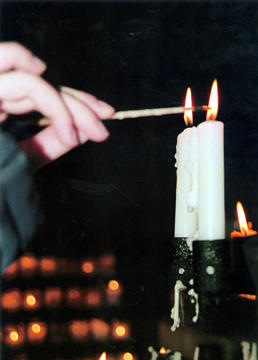
Yet even through my anger, I felt that when I was at the Grotto, God was near me and He was trying to make me understand what had happened. . . .
Last year, the Grotto became more than just a convenient link to God, but a link to my days at Notre Dame as well. Just before graduation, when the seniors made their last trip to the Grotto, I carried a candle from Sacred Heart Church to the Grotto. I can still remember exactly where I placed my candle. . . . That spot remains a link between me and my memories of the previous four years. It has made the Grotto . . . a symbol of Notre Dame and all this place has come to mean to me. . . .
I guess if anything good could possibly have come from last week's fire it is that I now appreciate the Grotto more and realize more fully the unique role it plays in my life and the lives of many others around campus. . . .
Mike Wilkins was in good company in sharing his heartfelt feelings about the Grotto. I am sure he, in turn, was inspired by the personal expression of Tom Dooley whose memory will always linger at the Notre Dame Grotto.
In a 1973 Sawadee, a publication of the Thomas A. Dooley Foundation, the Dooley Dome which housed refugee clinics is pictured. These small attractive futuristic dome buildings were set up as clinic stations to replace the tents and shelters normally used by the Dooley medical teams during the examination and treatment of patients as protection from the constant rain (depending upon the season). By curious coincidence or design, they are reminiscent of the Golden Dome image of Notre Dame.
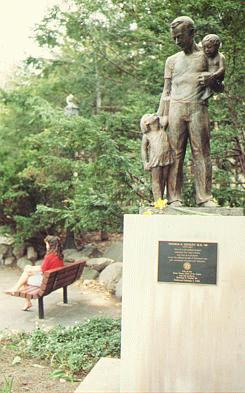
On October 16,1985, the Observer recorded an honor paid to Tom Dooley almost 25 years after his death. He became famous in the 1950s as the "jungle doctor of Laos." On October 15, 1985, 21 days after the fire at the Grotto, Dooley's humanitarian efforts were enshrined on campus with a statue, donated by the Alumni Association, which was placed just west of the Grotto.
By the time Dooley died in 1961, he had saved literally thousands of Southeast Asians. The statue shows Dooley posed with two Laotian children. . . . The Grotto was a favorite meditating place for Dooley during his years at Notre Dame. Father Daniel Jenky, rector of Sacred Heart Church, at the time, said the statue had been expected for a long time, but where it would be placed on campus was not known until the beginning of the semester. Placing the statue near the Grotto was fitting, Jenky said, because of how Dooley cherished the place and affirmed this in his letter to Hesburgh.
In the summer of 1996, during the celebration of its centennial, the Grotto's surroundings were newly landscaped, Dooley's letter at the kneeling rail of the Grotto was moved beside his statue and the area was landscaped with decorative plantings. Later a Memorial Bench was placed beside it. On it was this heartfelt tribute honoring another Navy doctor who loved the Grotto and died young:
Memory of
DANIEL C. GAUGHAN, M.D. '88
Keeper of the Grotto, Assistant Sacristan
Lt. Commander, Flight Surgeon, U.S.N.R.
Here he lies in the land of legends;
his heart of gold came home to rest
FAMILY and FRIENDS
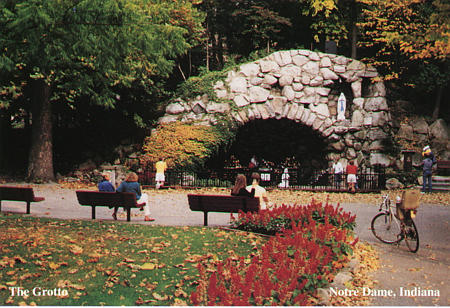
The Caretakers of the Grotto
Many caretakers have tended the Grotto over the past one hundred years. During the early 1980s, Franklin McMahon introduced the figure of Brother Roderic Grix, one of those many caretakers, in a painting he did of the Grotto.
Brother Rod began taking care of the Grotto in his twilight years when he was no longer able, due to a stroke, to carry on the constant repair work he did on campus. The Grotto painting which hung on a wall at the foot of his bed was admired by everyone who visited him. He always took pleasure in pointing to himself in it.
In the one hundred years the Grotto has enriched the campus there must have been an endless parade of unsung caretakers. Sweeping away the gathering leaves in the fall, cleaning the wax from the candle holders, replenishing its candles and lovingly caring for it.
Brother Roderic was only one of those many caretakers. After his stroke, his work at the Grotto was taken over by Brother Protase Bauer who tended the Grotto with his own special brand of devotion. He would bring the large glass candle containers back to Holy Cross House when the candles burned out. He had a large industrial bucket with sand in it, in which he had placed a light bulb on an extension cord. He used this method to melt the left over wax in the containers. He would then transfer the melted wax to a freshly washed candle holder and place a new wick in it. In this way, he recycled the used candle containers that, at that time, were thrown away. Later, he added an extra touch to them by having someone paint violets on the glass containers. Brother Protase was a quiet, kindly little man always friendly and solicitous to everyone he encountered. He had a fondness for bright, sunny daffodils. When he found them in the woods in excess, he would divide them and plant them somewhere else to bring cheer to anyone passing by on the campus
Another Brother who spent hours at the Grotto was Brother Cosmas Guttly. Corby Hall, adjacent to the Grotto area, was home to him for many years. A large screened-in porch overlooks a small court yard of greenery. It also overlooks the Grotto lawn, its park benches scattered among the trees. A constant parade of people pass by going to and coming from the Grotto.
Brother Cosmas was often seen tidying up the Grotto, resting, talking to people, and tending the flower beds there and around Corby Hall. Alice Osberger, a secretary on campus, was walking toward the Grotto on a lunch break one day when she saw Brother Cosmas hunched over a flower bed near Corby Hall. She thought he was ill and went to help him. She said when she got closer to him she realized that he was weeding it. He also helped in the the church and sacristy. For years this quaint, frail little man, with the round wire-rimmed glasses and skirted black cassock, was a familiar sight to many as he quietly served the priests during Mass at Sacred Heart Church. He was revered by priests and lay people alike as a very holy man.
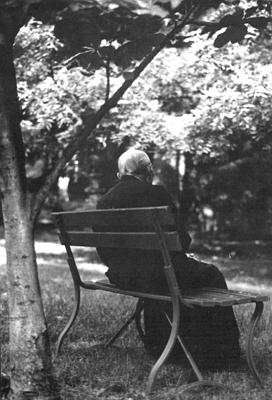
In between church services, and his other work, he was always at the Grotto. One day a week he would go to Holy Cross House, the retirement home for priests on the campus. There he would help his "good buddy," Brother Edward, attend the infirm priests who said their daily Mass in the long corridor of sit-down altars for use by priests in wheelchairs. Then he would return to the Sacred Heart Church in time for the 5 o'clock service.
Brother Cosmas came from Switzerland. He was a businessman before he became a Brother in mid life. He was gifted in many ways. His daily devotion to the Grotto and its surroundings, was captured in a unique, unidentified, full page photograph of him in the back of the 1990 Dome. He was sitting alone on a secluded park bench, dressed in his black cassock, head bowed, meditating or praying a little distance from the Grotto. With his back to the camera he could not have known the picture was being taken. Only those who knew Brother Cosmas well would have known it was him. Very soon after the picture was taken he was confined, by his infirmities, to Holy Cross House. He died there two months after his 99th birthday.
Herbie De Mike, an employee of the University, has taken care of the Grotto now for a number of years.
If your guest should be non-Catholic,
to make her feel at ease
introduce her to the Grotto first:
That's probably where you'll go first anyway.
Notre Dame Religious Bulletin
October 14, 1941
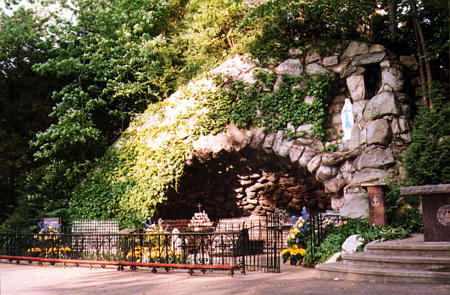
A New Focus on the Grotto
Five months after the fire, on February 13, 1986, an impressive article in The Observer brought renewed attention to this lovely campus shrine, undoubtedly too often taken for granted until the threat of loss was focused upon it. Kathy Martin the feature staff writer, speaks of the student experience:
Scarcely a student passes through the challenges, dilemmas, and triumphs of four college years here without taking refuge at one time or another in the peaceful silence of a moment of reflection before hundreds of glowing candles which are special prayers to the Virgin Mary. It is part of the Notre Dame experience and tradition.
The writer quotes the Rector of Sacred Heart Church:
Father Daniel R. Jenky, Rector of Sacred Heart Church, described the Grotto today as a place where 'even non-church-goers feel they can go to be quiet and pray.' He said that the atmosphere is 'unselfconscious and unpretentious, where normal, active people can share faith without it being a big deal.' Father Jenky noted the reaction of a visiting Canadian priest to the enormous numbers of students who came to the Grotto to pray, 'At Notre Dame, there is still the atmosphere that gives people permission to pray without looking like they're doing anything weird.'
He said he receives many letters and plaques of thanksgiving to mark prayers answered every year, but he cannot accept them. 'The walls would be completely covered,' he explained.
The Grotto is different from a church in a theological sense. 'People don't pray to Mary like they do to God,' Father Jenky said. 'God is God, but with Mary, we ask her to pray with us to God. She is a symbol of faith, the first disciple.'
The writer also quotes former Notre Dame President, Father Theodore Hesburgh who usually attends the Grotto every day when he is on campus:
'I really believe that Our Lady watches over this place. I feel I ought to stop in and say thanks, and also pray that she keeps watching over it.' he said. 'I usually get down there in the wee hours of the morning when I leave the office,' he continued. 'There is almost always someone down there, rain, sleet, or snow . . . . Every university has a place where students hang out for their social life, libraries where they study, and playing fields where they play sports, but how many have a praying place?'
The Grotto has also earned Father Hesburgh's own personal accolade: "I've been to shrines dedicated to Our Lady all over the world. Mary may visit them but she lives here at Notre Dame."
I've experienced that same feeling so many times in my research. She lives in the beauty of the lakes, the grounds, the church and in her image on the Dome, but most of all she lives at the Grotto in the hearts of all those who view it with fond affection. She is Keeper of the Flame of Faith wherever she is, but most especially at Notre Dame, where visiting her is never seasonal. She is always there whatever the season. Anytime during the day or night the light of her faith shines from every candle for everyone to see and be comforted by.
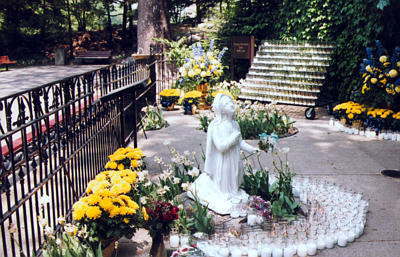
"Although there are thirty chapels in the dorms and elsewhere on the campus," Kathy Martin says, "the popular place to pray is the Grotto."
A freshman, Kathleen Flynn, says the Grotto makes her feel a part of Notre Dame:
I can stop on my way home from the 'brar' [library]. It makes me feel complete. It's not hokey-religious, just quiet and personal.
In a companion portion of the same Observer article, compiled by Doug Anderson, under the heading, "What does the Grotto mean to you?" Father Ron Wasowski speaks of its open outdoor setting:
It's not quite the same as the church, which is enclosed; this is outdoors. It's a place where people know prayer and devotion are welcome, where you can stop in very briefly and go on. I think it's very special because of that.
John Bruening offered this lovely thought:
On a cold winter night, it's one of the few places you can go to be by yourself, yet never feel alone.(325)
The Grotto occupies one of the most quiet, most secluded sites on campus. Its purpose has been realized because she is seldom alone. Students pause throughout the night and day to pray and perhaps light a candle.
Such a wondrous repository of wishes and prayers could not help but be filled with all the hopes and dreams of everyone who has ever paused there in reflection and prayer over the past 100 years. How pleased they would all be to know how much the Grotto is lifting the spirits and warming the hearts of countless visitors and passers-by, even now, more than 100 years later. How could anyone be lonely in the company of such a host of fellow travelers journeying through life. May the memory of all of them continue to bless this place of prayer and meditation -- most especially the spirit of Tom Dooley."
In a 1964 article in the Notre Dame Alumnus three years after Dooley's death, Father Thomas O'Donnell wrote of his own remembrance of the inspiration of Tom Dooley's poignant letter:
Sickness is a great thought provoker. When a person knows his disease or affliction is terminal he reaches back and grasps the great moments that helped him in the past and perhaps can help him now. This was the way with Tom Dooley. With aching fingers he spoke his heart on a typewriter. It does the soul good and warms our hearts to pause in our haste and remember the unhastening hours and the sun that dials its seasons on the aging stone of the Grotto.
The last sentence of Fr. O'Donnell's remembrance has reminded me of one of my own. I was waiting at the library entrance for my ride home when I noticed a handsome young man waiting beside me. We struck up a conversation about the weather. "Are you from South Bend," I asked. "No," he said, "Florida." When I asked him if he was new to the winter weather he told me that he had been in Massachusetts in the winter but in the five years he'd been at Notre Dame the winter weather had been mild. We exchanged appreciation for the beauty of the campus and then I asked my usual question.
"Have you been here long enough to be fond of the Grotto?" I asked him. "Oh yes," he said. "I love the Grotto. My wife and I were walking on the campus one evening with my mother who was visiting from Argentina. It was nearing dusk, the campus was quiet and still as we turned and walked toward the Grotto. The setting sun settled in an orange glow over the cavern of candles. In unison, we stopped, so taken by the beauty of the sunset on the Grotto that it was like an ethereal experience. The three of us have never forgotten it and often speak of it to one another."
It was just a brief encounter, we did not even exchange names, but his vivid description of the setting sun on the Grotto also made an indelible impression upon me.
One never knows where the inspiration will come from. One day early on in my research, upon leaving the Hesburgh Memorial Library, a fellow researcher new to the campus asked me about the special places to visit on his last day there. I told him about "my Notre Dame" and my favorite place on campus -- The Grotto. Like myself, the first time I was invited to see the St. Stan's Grotto, he asked me, "What's a Grotto?"
Intuitively, the answer came: "It's a cave of candles." I have never since thought of a better way to describe it. Long before electricity, candles were used to illuminate the darkness. It is the truest image of the Grotto. Like Mary, candles light the way. They reflect the light of her faith. And what better place than a lowly dark cave, where her light might shine all the brighter. Jesus was born to Mary in a darkened stable; Bernadette spoke of the vision that appeared to her as the "Lady dressed in light." The candle is a symbol of the human soul. The flames of the candles, like hands folded in prayer,(326) are symbolic of the light of inspiration with which she shows the way. The image of Mary in her niche, illuminated in a golden glow, is a reminder of the love and compassion -- the unshakeable faith -- her life represented.
Lighting a candle of hope at the Grotto, or in our hearts, as Dooley did by letter, is giving wings to our wishes and prayers. It's an outward expression of an inward resolve to believe -- and go right on believing, no matter what -- as Mary did. It puts a period to our prayers. We are comforted by an inner reassurance: "I've done all I can, the rest I leave in God's Hands."
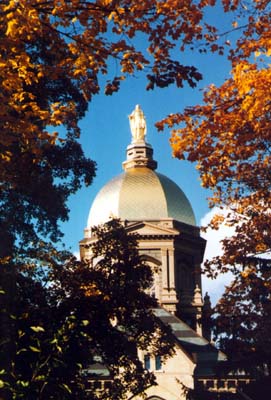
The heavenly blue associated with Mary, the blue of the sky, the blue of the lake, the beauty of nature surrounding the Grotto exemplify Mother Nature as Mary exemplifies the nurturing qualities innate within all of us. Mary appeared to Bernadette at the Grotto of Lourdes because she wanted a simple secluded spot where people could come directly to her -- like a child to its mother. A warm friendly place where all would feel welcome, regardless of their religion.
It has been said that the sweetest words in the English language are mother, heaven, and home -- Mary represents them all. Her shining image has been raised aloft on the Golden Dome to uplift and inspire and in our midst at the Grotto to comfort and console.
Father Schaerf, on the occasion of Notre Dame's celebration of the 100th centenary of Our Lady of Lourdes Grotto in France in 1958, spoke of its spiritual miracles:
You know the story of Lourdes and the one word that astounds the world: miracle, something that cannot be explained by the laws of nature. Everyone knows of the physical cures, but the thousands of unwritten cures of the uncured: The miracles of resignation, these are the baffling paradoxes. The miracles of the conversion of the heart are astounding to those without faith.(327)
The dictionary defines a miracle as: "a wonderful happening, something marvelous, a wonder." Just being unexpectedly planted on this trail of memories has been a continuous wonder to me.
From the very day I began following the muse that first led me to the University Archives, I have marveled at all the lives that have been touched by that "ineffable essence" that is the spirit of Notre Dame, Our Lady, and the Grotto. I hope taking readers down that unexplored trail with me has been as much pleasure to them as telling the story behind the Grotto has been to me.
In 1950, Father John E. Fitzgerald penned these words about that special feeling that radiates from the Grotto and touches the heart:
It's quiet and shady there. Just what there is about the place can't be described because it's different for everyone. Nobody knows how many candles have been burned or prayers answered there. From the great Golden Dome of her University Our Lady reigns as our Queen. Yet at the Grotto she seems to have stepped down a little closer to us that she might emphasize the other side of her personal relationship with us -- that of Our Mother." The beauty of nature surrounding the Grotto, the candleglow, the comforting listening presence to turn to, brings solace in all our troubles.(328)
Another writer describes the Grotto as he saw it in 1899:
In order to appreciate the beauty of St. Mary's Lake and the Grotto, go when the sun is hung in the horizon's haze; then the spires of St. Mary's Academy are rounded and mellowed and the lake bosom is lit with dancing wave bands of opal and turquoise and orange, and the graceful trees near the grotto let their leaves pulsate in the quivering light.(329)
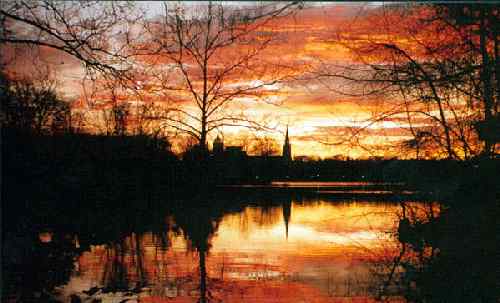
Almost 100 years after the writer above painted in words his vision of a sunset at the Grotto, Fr. Wm. Blum, C.S.C., was blessed with this memorable photograph he took of a glorious sunrise over Our Lady of the Lake and her Grotto. Visualizing the sunglow on the Grotto "when the sun is hung in the horizon's haze" and the sky is ribboned with a rainbow of colors is a very special remembrance of mine -- once experienced never to be forgotten.
On that memorable Feast Day of Our Lady of Snows, after the statue and the Grotto were blessed and Father Corby gave a brief sermon, the over five hundred assembled for its dedication departed, many returning throughout the twilight hours. This lovely remembrance of that day was recorded almost one hundred years ago in an 1896 Scholastic. It seems only fitting to share it on the eve of its 100th Anniversary:
. . . white with the snow of moonlight, the thin mist above the mirrored planets on the lake was like the Madonna's veil. When all left only Our Lady of Lourdes stood there in the moonlight and the crickets chirped steadily in the long dewy grass.(330)
Well over one hundred years ago, Timothy Howard penned this ageless tribute to the University dedicated to Our Lady of the Lake. It is as true today as it was then: "Whoever leaves Notre Dame hopes to see it again."(331)
A multitude of people have paused in reflection and prayer at this peaceful wayside shrine since that day. Others yet unborn will follow in their footsteps, as we are doing today and others will do tomorrow. May that river of blessed humanity that has become the spirit of Notre Dame continue to flow; beneath the Dome; through the Basilica; past the Grotto; along the lakes; through the ages, for endless generations to come . . .
BLESSINGS FROM HEAVEN BE UPON ALL THOSE WHO NOW TAKE CARE
OF THIS GROTTO AND UPON THE PEOPLE, YOUNG AND OLD, WHO COME
HERE TO OUR BLESSED MOTHER AND DEVOUTLY PRAY TO HER.
(332)
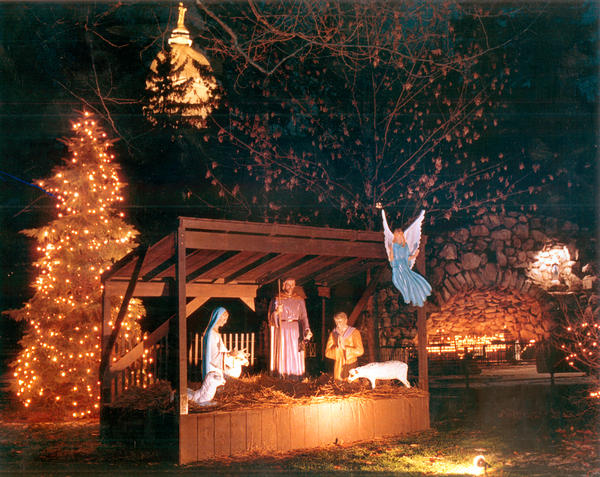
Christmas Eve at the Grotto
by Dennis White / Courtesy South Bend Tribune